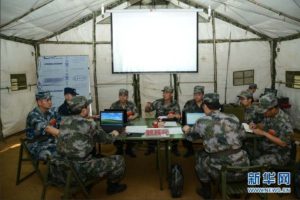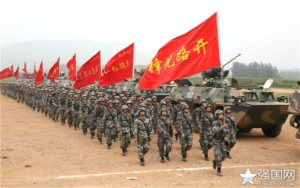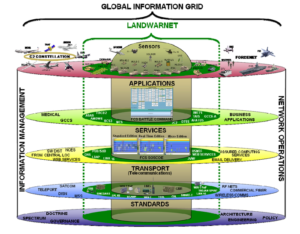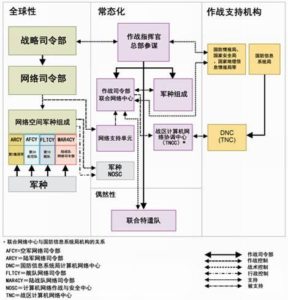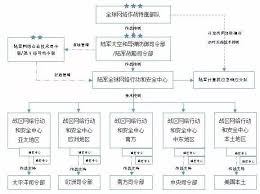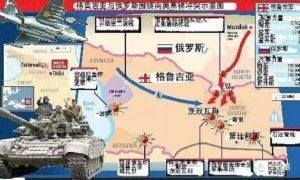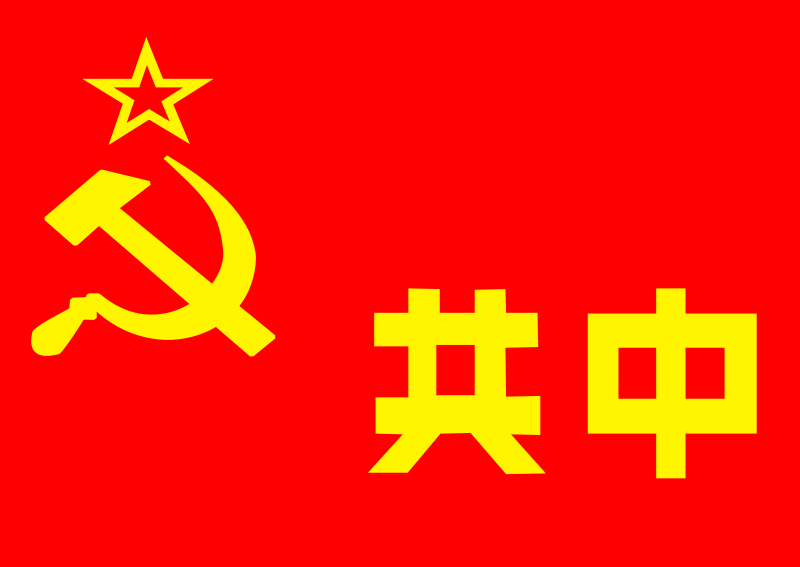China’s Blurred War: Trends of Future Battlefields //
中國模糊戰爭:未來戰場的發展趨勢
With the continuous development of information technology, changing the form, nature and scale of war, so that the combat style, combat methods, combat environment, combat conditions and other elements have been a lot of changes in the past, the future battlefield becomes more blurred, Can be summarized as the following:
War scale and level ambiguity
War in size and level, can be divided into strategies, campaigns and tactics, in the past, the difference between the three very obvious. From the three interrelationships, the strategy decides the battle, the battle determines the tactics, and the tactics reacts to the battle, the battle reacts to the strategy, which is the inherent law of the existence of the war itself. With the development of information technology, the development of high-tech war as information war, although not fundamentally change the strategic, campaign, tactical and counter-role of this dialectical relationship, but it makes the strategy, battle, tactical action scale increasingly blurred. This is because, under the conditions of information under the conditions of local war, the size and use of troops, weapons, limited duration of war, political prominence, war and strategy, battle, tactics combined very closely, tend to one. Information weapons and weapons to combat high precision, powerful, long range, with all-weather, all-weather combination of peaceful reconnaissance and combat integration capabilities for the rapid realization of the purpose of war to provide an effective means, sometimes do not use large forces can Reach the strategy, the battle target. Any combat unit, and even the individual combat operations, can get a strong information and fire support. Under their influence, tactical combat can directly achieve strategic objectives, strategic command can be involved in the tactical level is no longer a dream at any time. Thus, in the past through the local small victory gradually integrated into a strategic victory of the operational theory of the impact of the strategy, campaign, tactical three combat levels between the increasingly blurred.
Therefore, in the future information operations, the two sides will fight with the uncertainty of the scale of operations, to take over-the-line precision strike, non-programmatic “acupuncture” and structural damage and other tactics, against each other’s battlefield awareness system and information systems Quickly achieve the purpose of fighting. In this way, the special operations forces on the battlefield may be able to show their talents, that is, before the war secretly penetrate the enemy, direct attack and paralyze the enemy command and control system, so that the enemy lost control of its combat forces, and thus into the chaos of command, The Although the scale of the operation of the smaller, but for the outcome of the war can play a very important role.
Weapon equipment and functional blur
Technical decision tactics, also determines the army’s system and the composition of military and arms. For example, the emergence of weapons and equipment such as artillery, chemical weapons and radio telegraphy, laid the material foundation for the emergence of new arms such as artillery, chemical warfare, and communications. In terms of military services, due to the emergence of the aircraft, and then produced the Air Force; ship advent, gave birth to the Navy. Industrial era, the requirements of the division of labor, so refined and produced more and more professional, reflected in the composition of the army, is the division of arms and branches more and more fine; information age, requires the overall combat, the professional Close cooperation, and take the road of integrated and integrated operations. Reflected in the composition of the military trend, is the integration of combat systems. For example, many of the future weapons and equipment system will form an independent combat unit, both to complete the army requirements of the combat mission, but also to achieve the Air Force’s operational requirements, but also to achieve the purpose of naval combat. In other words, when the future combat aircraft’s infinite capacity to extend, and beyond the atmosphere combat; Army bid farewell to the “ground crawling” to achieve global arrival, global operations; the Navy to the sea to land, to the air combat capability transformation, Battle will inevitably lead to integrated forces. Integrated combat troops, generally composed of armored forces, artillery, mechanized infantry, missiles, attack and transport helicopters, naval vessels and other components, can independently combat, will realize the professional army to the professional army transition.
Military combat operations and the preparation of fuzzy war
Military combat forces have different targets and perform different combat missions. World War II, combat forces mainly infantry-based, basically infantry and infantry confrontation; the Second World War, due to the development of weapons and equipment, aircraft, tanks, cannons for war, arms and arms between the combat The task has a distinct distinction, usually performing a different combat mission. However, under the conditions of information in the local war, due to the development of weapons and equipment to the direction of multi-functional integration, the establishment of the army, not only the arms, as well as various services. Combat forces can perform both ground combat missions, but also the implementation of the fight against air and sea objectives and tasks, so that the boundaries between the military operations will be difficult to distinguish. For example: destroy the enemy tank weapons, may have been the Army’s tanks or anti-tank weapons, it may be the Air Force aircraft or naval submarines launched “smart” missiles. The US military plans to form four integrated forces: an integrated ground force composed of armored forces, artillery, flying warriors, attack and transport helicopters: air-to-air mechanized units with “flying tanks”; air force mixed knits composed of multiple models and A “joint task force” consisting of various military units. The Russian army intends to form a “multi-purpose mobile force”, an “aerospace force” composed of ground, air and space forces, and a “non-nuclear strategic deterrent force” composed of non-strategic nuclear forces.

War motives and ambiguity
The motive of the traditional war is generally the political struggle to cover up the economic interests of the dispute. In the information age, the economic interests of the dispute will continue to lead to the root causes of the war, but in addition, due to the international and domestic political forces between the various contacts increased, closely linked, which will inevitably lead to various countries, And the conflicts between the societies caused by political, diplomatic and spiritual factors have increased, so that the contradictions between religions and nationalities have increased, so that violence can be smuggled and drug trafficking and terrorist activities are internationalized. These contradictions and conflicts are not only the direct cause of the “sub-war operations”, but also one of the causes of the war. The direct cause of the Gulf War in 1991 was the convening of the United Nations Security Council immediately after Iraq’s invasion of Kuwait on 2 August 1990, the adoption of resolution 660, condemning Iraq’s invasion of Kuwait, and demanding that Iraq be unconditionally withdrawn from its forces. The United States for the protection of Western oil sources and in order to establish a new order in line with the interests of the world’s new order, take the lead in the implementation of economic sanctions against Iraq, followed by the United States led the multinational force to implement the UN Security Council resolution in the name of the troops to the Gulf. Through 42 days of war, the US military reached the purpose of the war. The war in Iraq, the United States to Iraq has a weapons of mass destruction on the grounds, without the authorization of the United Nations launched an injustice war. Throughout the war, the focus of US military operations against Saddam Hussein and a handful of Iraqi high-level leaders, and to find weapons of mass destruction and launched the attack. Although the war has overthrew the Saddam regime, the United States still has not found strong evidence that Iraq has such banned weapons. In this war military purpose, the United States is also to test the new operational theory.
In recent years, the US military vigorously advocated military reform. The theory of the war in Iraq is the theory of “cyber-centric warfare” and uses the new theory of “shock and deterrence” put forward in 1996: emphasizing the use of violent firepower, shocking against opponents, regardless of frontier and depth, The enemy to combat, the use of advanced precision guidance technology, against each other’s goals when one side of the pursuit of both sides less casualties; air and ground operations at the same time, the purpose is to destroy each other’s will, so that its regime collapse, so as to achieve war and subdue The purpose of the soldiers. In the Iraq war, the US military did not carry out large-scale strategic bombing, but the use of high-tech and special forces tactics to combat, which is one of the main achievements of US military reform.
War attack and defense blur
The process of attack and defense in the past is very clear, the attacking party usually in accordance with the offensive preparation, breakthrough, shock, deep combat and other step by step attack procedures, defense side in accordance with the defense preparation, fire against the preparation, anti-impact, deep combat and other sub-combat operations Attack and defense both sides of the various stages of combat orderly. The development of high-tech weapons and equipment and information technology, the new military revolution will change the future combat procedures, combat operations will break through the fixed battlefield and position constraints in the entire operational space at all levels, all directions, all aspects of the same time. In this way, the front and rear lines in the past are blurred, the relatively stable front and fixed battlefields no longer exist, the line of offensive action and defensive action because the battlefield’s high mobility and uncertainty also become blurred and influence World military force balance. Offensive and defensive both offensive and defensive combat, especially offensive and defensive information war will become the focus of future combat art, so that every war has attack in the defense, anti-attack.
Attack and defense operations will be in the land, sea, air, days, electricity and outer space and front and depth, front and wing side, front and rear at the same time, the battlefield frequent mobility, line combat style has not adapted to the conditions of local war development Need to, instead of non-line operations, the formation of a “island-based combat base”, front and rear of the line, the enemy and the two sides of the front becomes blurred, the battlefield of the flow of non-linear or non-state state of the multi-dimensional battlefield.
Measure the outcome of the war with the standard fuzzy
In the past, the criteria for measuring the outcome of a war usually refer to how many troops are wiped out, how many weapons are seized, how many cities and territories are occupied, but in the case of local warfare, the criteria for measuring the outcome of a war are not just that. Under the conditions of information, local warfare, political purpose and war are closely integrated, war attempts often not through the invasion of each other’s territory, wiped out the enemy or the enemy completely surrendered, so as not to lead the world public opinion and the people’s strong opposition, resulting in political Passive.
One of the hallmarks of information warfare is that it minimizes casualties, in particular, collateral damage, and often uses precision-guided weapons to strike precisely, to avoid heavy assault, face-to-face fights, and fight against Libya “Surgical” operations, the implementation of air long-range maneuvers, to achieve the purpose of war; also the implementation of missiles, thousands of miles away siege warfare, but also to achieve the purpose of local war; also like the Gulf War, do not occupy its territory, Do not kill their soldiers a soldier, not seized its weapons, ammunition, the implementation of large-scale air strikes, weakened its military facilities, destroyed its regime.
The war army is blurred with the people
In previous wars, the links between the army and the society were relatively “loose” due to restrictions on information infrastructure and technology; pure war weapons and equipment also led to military organizations that were completely independent of the people. Information age, information has become a link between the military and the people, this combination, with the social and military information degree of development, integration will also continue to improve. This makes society and ordinary people no longer a spectator of war, and even not only in support and subordinate status, but with the army, from the back of the war to the front desk.
As people see, on the one hand, the purpose of modern warfare is no longer simply pursuing siege and the greatest annihilation of enemy forces, the target is no longer confined to the enemy’s heavy military and military facilities, but includes Corresponding to the survival and operation of the infrastructure, such as: financial networks, power grids, transport networks, administrative networks, communications networks. On the other hand, the war has a tendency to “civilians”. For example, information makes the “non-state” has the ability to confront national power. Any “non-state subject”, as long as there is a certain technical and information equipment, you can attack the vital goal of a country, its harm is sometimes no less than a traditional sense of the war. Such as Al Qaeda attacks on the United States launched the 9.11 attack, that is the case. Although the composition of the information warfare forces, although still have traces of the war in the past war, but in the form of form and combat quality, due to more information to join the content, in particular, more to join the information of the whole society Warfare ability, so no doubt to determine the specific role of information warfare when the thinking tends to blur, but for combat decision-making and command to bring greater difficulties. With the in-depth development of information technology, the degree of social information will be greatly improved. In this case the information war, it is more prominent military and civilian compatibility characteristics. Especially in the information warfare, many high-tech work, alone, the strength of the army is difficult to complete independently, but also the need for the whole social forces of collaboration, which makes the information warfare combat power, more into the national factors.

Combat both forces with contrast and blur
In the past, the strength of the war between the two sides, usually the number of military personnel, the number of weapons to measure the number of weapons to determine the strength of the advantages of planning and combat operations. But in the information under the conditions of local war, concentrated forces of content and methods have changed. The strength of the comparison is not only the number of considerations, but also mainly consider the quality, in particular, to consider the concentration of firepower and information, a variety of long-range strike weapons do not need to focus on deployment, you can focus on the implementation of the target surprise. To make the concentration of fire after the effective role, but also must focus on a lot of information, otherwise they can not capture, track and destroy the target. The most important weapon in military forces will no longer be a high-performance fighter, bomber, tank, warships, but a huge flood of data from the information system. Invisible information and knowledge, like armored masters, play a huge role in combat and are increasingly becoming the most important combat and power multiplier. Computing power, communication ability, reconnaissance ability, processing ability, decision-making ability, computer simulation ability, network warfare and other information and knowledge factors will become a key factor in measuring military power.
The contrast of military forces is increasingly dependent on the invisible and difficult potential of the intelligence and structural forces of the information weapons system. Therefore, in the past according to the number of combatants and tanks, aircraft, artillery, warships and other weapons and equipment performance, quantity and other static indicators to assess the strength of military strength is clearly challenged. Because of the intelligence of the information weapon system, the structural force has great potential for dynamic. The strength of the Gulf War contrast and the outcome of the war can explain this problem. Before the war, Iraq and the multinational force compared to 1.6: 1, but the result of the war is the Iraqi army casualties for the multinational force 100 times. Obviously, if not a large number of multinational force weapons system to play a multiplier combat potential, there will be no such a war situation. It can be seen that the principle of force assessment of the number of static quantities will be replaced by a new force theory.
Battlefield information is true and false
Because of the development of information technology, and widely used in future war, so that a large amount of modern war information, processing information has been very difficult. Such as: the US Strategic Air Force Command, an average of more than 815,000 per month to deal with military information, almost 26,500 copies per day. In the Gulf War, the multinational force in the 42 days of combat, dealing with up to millions of military information. Only the US Army logistics will handle 10,700 copies of military information every day. After the military, weapons and equipment and the battlefield are digitized, the military information highway will cover the entire combat space, the information is true and false, there are new and old, heavy and light, there is real, there are thick and so on, information Like the tide to the red and blue both sides of the command came. In such a fast-paced, fighter fleeting, information massive battlefield environment, to the red and blue commander of a brief decision-making time, forcing both commanders in the complex battlefield information forging discrimination, analysis and judgment, quick decision-making , Through the phenomenon to seize the essence, improve the command ability.
Battlefield space and scope is blurred
Battlefield is the enemy of the two sides of the interaction between combat forces and combat forces and firepower to kill the maximum distance. In the past war, due to the level of weapons and equipment constraints, cold weapons era battlefield space, basically confined to the war between the two sides of the visual distance; hot weapons and mechanized war era, battlefield space by the firearms and the two sides of the maneuverability And the battlefield space is expanding, and from a single land battlefield, to the development of the marine battlefield and air battlefield; combat distance from the visual distance to the development of remote and ultra-long-range , The depth and dimension of the battlefield continue to expand. After entering the information warfare, with the development of military weapons and equipment and structure changes, modern warfare space from the traditional land, sea and air to space, computer space, especially information, psychology, electromagnetic, cognitive and other virtual space expansion , In addition to the range of modern weapons and equipment and a substantial increase in mobility, the future battlefield in front and rear become increasingly blurred, in addition to the solid space in the solid before and after the exception, in the dynamic action space has no difference. Fighting may start from the front, it may start from the depth. Especially the establishment of digital forces, so that the army choose the way of combat operations, with greater freedom and flexibility. At the same time, but also to accurately determine the other side of the operational space and the exact location of the space, increasing the complexity. First, information weapons greatly improve the military’s ability to war, so that the military battlefield combat more flexible way. Second, information weapons greatly enhance the military’s full-time, all-round rapid mobility, so that information warfare warfare areas to expand.
Military aerospace capacity and long-range air transport capacity, the extensive use of armed helicopters, to achieve long-range rapid maneuver provides a good material basis. Future information warfare, or in three-dimensional space or in four-dimensional space, generally difficult to accurately grasp. And only when the other side of the combat operations to a certain size, it is possible to make a relatively accurate judgments, which to some extent increased the difficulty of command and control. The ambiguity of combat space is also manifested in the fuzzy scope of combat operations. As the future of information operations will break through the frontier to the depth of the gradual advance of the pattern, in a multi-dimensional space within the full range, full depth of the war, so that the scope of combat operations increased, combat space has become elusive. The uncertainty of the scale of combat operations in the information warfare determines the diversity of combat space. This also makes it possible to judge the space of the other combat operations, become blurred, and show the characteristics of difficult to predict and control.

Combat methods and methods are blurred
Advanced information technology, not only to achieve the real-time reconnaissance intelligence and digital battlefield, greatly improving the combat effectiveness of the army, more importantly, there have been many new means of warfare: such as information warfare momentum and power to make enemies Information deterrence; to disperse, conceal and open the information channel of the information shielding; on the enemy battlefield awareness system and information system implementation of information attacks; through the information system hidden false information fraud and information cut, computer virus attacks , Special operations, psychological warfare, non-contact operations, non-fatal attacks, structural damage warfare, these combat methods used in information warfare, completely changed the past offensive and defensive procedures clear and coherent characteristics, so that the use of combat means Order, combat form of non-model and other characteristics of more and more prominent, and then led to the information warfare, the use of the enemy means of warfare, timing and methods, become more difficult to guess. In the process of the combination of fuzzy, that is, in the course of the war, due to the enemy due to the appropriate choice of means of attack, and flexible combination, so that the enemy can not determine what the other side will take the means of combat, can not effectively take the appropriate protective measures. In the use of the timing of the fuzzy, that is, according to the intention of war and combat purposes, for different stages of combat and different areas of combat, to take different means of attack, reduce the enemy resistance will make it in trouble. In the fight against the ambiguity of the target, that is, the use of information warfare means of diversification, for the needs of information operations, both sound East West, but also the East and East, the flexibility to combat the enemy command center, communication center or radar station, air defense system , Logistical support systems and other key nodes, so that the enemy is difficult to use the means of my war to make accurate predictions.
原文網址:https://read01.com/j7m0M8.html
Original Mandarin Chinese:
隨著信息技術的不斷發展,改變了戰爭的形態、性質和規模,使作戰樣式、作戰方法、作戰環境、作戰條件等諸要素已較以往發生了諸多變化,未來戰場變得更加模糊不清,可歸納為以下幾種:
戰爭規模與層次模糊
戰爭在規模和層次上,可劃分為戰略、戰役和戰術,在以往戰爭中三者之間的區別十分明顯。從三者相互關係上,戰略決定戰役,戰役決定戰術,而且戰術反作用於戰役,戰役又反作用於戰略,這是戰爭本身存在的內在規律。隨著信息技術的發展,高技術戰爭發展為信息化戰爭,雖然未從根本上改變戰略、戰役、戰術這種作用與反作用的辯證關係,但是卻使戰略、戰役、戰術行動規模的日益模糊。這是因為,信息化條件下局部戰爭目的、規模和使用兵力、兵器有限,戰爭持續時間短,政治性突出,戰爭與戰略、戰役、戰術結合得十分緊密,趨於一體。信息化武器和兵器打擊精度高、威力大、射程遠,具有全天候、全時空的平戰結合的偵察與打擊一體化能力,為迅速達成戰爭目的提供了有效手段,有時不動用大部隊也能達成戰略、戰役目標。任何一個作戰單元,甚至是單兵的戰鬥行動,都能得到強大的信息和火力支援。在它們的作用下,戰術打擊可以直接達成戰略目的,戰略指揮可以隨時介入戰術層次已不再是夢想。由此可見,以往通過局部小勝逐步匯集成戰略性勝利的作戰理論受到衝擊,戰略、戰役、戰術三個作戰層次間的界線日益模糊。
因此,在未來信息作戰中,作戰雙方都將以不確定的作戰規模,採取超視距精確打擊、非程式化「點穴」和結構破壞等戰法,打擊對方的戰場感知系統與信息系統,以便迅速地達成作戰目的。這樣,戰場上的特種作戰部隊就可能大顯身手,即在戰前秘密地深入敵後,直接攻擊和癱瘓敵指揮控制系統,使敵失去對其作戰力量的控制,從而陷入指揮混亂、協調無序的困境。這種規模的作戰雖然較小,但對於作戰的勝負卻能起到極其重要的作用。
武器裝備與功能模糊
技術決定戰術,同樣也決定著軍隊的編制體制和軍兵種構成。例如,火炮、化學武器、無線電報機等武器裝備的出現,為炮兵、防化兵、通信兵等新兵種的出現奠定了物質基礎。就軍種而言,由於飛機的出現,進而產生了空軍;船舶的問世,催生出了海軍。工業時代,要求的是分工合作,所以細化和產生的專業越來越多,體現在軍隊的構成上,就是軍兵種劃分得越來越細;資訊時代,要求的是整體作戰,各專業之間密切協同,走集成一體化聯合作戰之路。反映在軍隊的構成趨勢上,就是作戰系統的一體化。比如,未來許多武器裝備系統將形成一個獨立的作戰單元,既可完成陸軍要求的作戰任務,也可實現空軍的作戰要求,還可達到海軍的作戰目的。換句話說,當未來作戰飛機的續航能力無限延長,並超越大氣層作戰;陸軍告別「地面爬行」,實現全球抵達、全球作戰;海軍實現由海到陸、到空的作戰能力轉化之時,一體化作戰必然催生一體化部隊。一體化作戰部隊,一般由裝甲兵、炮兵、機械化步兵、飛彈、攻擊和運輸直升機、海軍艦艇等組成,能獨立作戰,將實現專業軍隊向職業化軍隊過渡。
未來一體化部隊將主要表現為,將打破傳統的陸、海、空、天等軍種體制,按照系統集成的要求,建立「超聯合」的一體化作戰部隊。未來信息化戰爭是高度一體化聯合作戰,使用傳統的諸軍種力量實施聯合作戰,已難以適應這種高度一體化聯合作戰的需要。為此,未來軍隊組織的編成,將打破傳統的陸、海、空、天等軍種體制,按照偵察監視、指揮控制、精確打擊和支援保障四大作戰職能,建成四個子系統,即:探測預警子系統、指揮控制子系統、精確打擊與作戰子系統和支援保障子系統。這四個子系統的功能緊密銜接,有機聯繫,構成一個相互依存龐大的一體化聯合作戰系統。按照這個思路構建的軍隊,將從根本上拋棄工業化時代軍隊建設的模式,革除偏重發揮軍種專長和追求單一軍種利益的弊端,使作戰力量形成「系統的系統」或「系統的集成」,從而能夠充分發揮整體威力,實施真正意義上「超聯合」的一體化聯合作戰。
軍兵種作戰任務與編制模糊
軍兵種作戰力量具有不同的打擊目標和執行不同作戰任務。第一次世界大戰,作戰力量主要以步兵為主,基本上是步兵與步兵的對抗;第二次世界大戰,由於武器裝備的發展,飛機、坦克、大炮用於戰爭,軍兵種之間的作戰任務有了明顯區分,通常執行不同的作戰任務。但是在信息化條件下局部戰爭中,由於武器裝備向多功能一體化方向上發展,部隊的編制內,不僅有各兵種,還有各軍種。作戰部隊既能執行地面作戰任務,又能執行打擊空中和海上目標任務,使軍種間作戰的界線將不易區分。例如:摧毀敵方坦克的兵器,可能是已方陸軍的坦克或反坦克兵器,也可能是空軍的飛機或海軍潛艇發射的「智能」型飛彈。美軍計劃組建四種一體化部隊:由裝甲兵、炮兵、飛彈兵、攻擊與運輸直升機組成的一體化地面部隊:編有「飛行坦克」的陸空機械化部隊;由多機種組成的空軍混編聯隊和中隊;由各軍種部隊組成的「聯合特遣部隊」。俄軍擬組建集各軍兵種於一體的「多用途機動部隊」,由地面、空中和太空兵力組成的「航空航天部隊」,以及由各軍種非戰略核力量組成的「非核戰略威懾部隊」。
在未來信息化局部戰爭中,武器裝備向多功能、一體化方向發展,部隊的編制趨向混合化、小型化。作戰中,各軍兵種圍繞既定的作戰目標,彼此依存,融為有機的整體。在戰場上,各軍兵種將在陸、海、空、天、電等多維領域,圍繞統一的作戰目的,既在活動空間上相對獨立,又在作戰行動上高度融合,使得不同軍兵種所執行的任務界線變得更加模糊。

戰爭動因與目的模糊
傳統戰爭的動因一般是政治鬥爭掩蓋下的經濟利益之爭。在資訊時代,經濟利益之爭仍將是導致戰爭的根本原因,但除此之外,由於各國之間、國際國內各派政治力量之間交往增多,聯繫密切,這就必然導致各個國家、民族、社團之間由政治、外交、精神等因素引發的衝突增多,使宗教、民族矛盾上升,使暴力活動、走私販毒、恐怖活動國際化。這些矛盾與衝突不僅是「亞戰爭行動」的直接根源,也是導致戰爭的動因之一。1991年海灣戰爭直接動因,是1990年8月2日伊拉克入侵科威特之後,聯合國安理會立即召開會議,通過了660號決議,譴責伊拉克入侵科威特,要求伊拉克無條件從科撤軍。美國出於保護西方石油來源和為建立符合其利益的世界新秩序的目的,乘虛而入帶頭對伊拉克實施經濟制裁,隨後以美國為首的多國部隊以執行聯合國安理會決議為名,出兵海灣。通過42天的交戰,美軍達到了戰爭目的。伊拉克戰爭,美國以伊拉克擁有大規模殺傷性武器為由,沒有經過聯合國授權而發動的一場非正義戰爭。整個戰爭中,美軍作戰的重心是針對薩達姆等少數伊拉克高層領導人,並以尋找大規模殺傷性武器而展開的攻擊行動。雖然戰爭已經推翻了薩達姆政權,但是美國至今仍然沒有找到伊拉克擁有這種違禁武器的有力證據。在這場戰爭軍事目的上,美國也是為了試驗新的作戰理論。
近幾年,美軍大力倡導軍事變革。指導伊拉克戰爭的理論是「網絡中心戰」理論,並運用1996年提出的「震撼與威懾」的新理論:強調運用猛烈的火力,震撼性打擊對手,不分前沿和縱深,全方位迅速地對敵人進行打擊,運用先進的精確制導技術,打擊對方目標時片面追求雙方較少的傷亡;空中與地面行動同時展開,目的是摧毀對方的意志,使其政權崩潰,從而達到不戰而屈人之兵的目的。伊拉克戰爭中,美軍沒有進行大規模的戰略轟炸,而是利用高技術加特種兵的戰術進行作戰,這是美軍軍事變革的主要成果之一。
戰爭進攻與防禦模糊
以往攻防作戰的程序十分明,進攻一方通常按照進攻準備、突破、衝擊、縱深作戰等步步進攻程序進行,防禦一方按照防禦準備、火力反準備、反衝擊、縱深抗擊等分段抗擊作戰程序進行,攻防雙方各個作戰階段展開有序。而高技術武器裝備和信息技術的發展,新軍事革命將改變未來作戰程序,作戰行動將突破固定的戰場和陣地的限制,在整個作戰空間的各個層次、各個方向、各個方面同時進行。這樣一來,以往戰爭中的前後方界線模糊,相對穩定的正面和固定的戰場不復存在,進攻行動和防禦行動的界線因為戰場的高度流動性和不確定性也變得模糊不清並影響世界軍事力量平衡。攻防兼備、攻防一體作戰尤其是攻防一體的信息戰將成為今後作戰藝術的焦點,使每一次戰爭都有攻中有防、防中有攻。
攻防作戰將在陸、海、空、天、電以及外層空間和前沿與縱深、正面與翼側、前方與後方同時展開,戰場機動頻繁,線式作戰樣式已不適應信息化條件下局部戰爭發展的需要,取而代之的是非線式作戰,形成一種「島嶼式作戰基點」,前方與後方的界線、敵我雙方的戰線變得模糊,戰場呈現流動的非線性或無戰線狀態的多維立體戰場。
衡量戰爭勝負與標準模糊
以往衡量一場戰爭勝負的標準通常指的是殲滅對方多少兵力,繳獲多少武器,占領多少城鎮和領土,然而在未來信息化條件下局部戰爭中,衡量一場戰爭勝負的標準已不只是這些。信息化條件下的局部戰爭,政治目的與戰爭結合得緊密,戰爭企圖往往不通過侵入對方領土,全殲敵軍或使敵方徹底投降,以免引發世界輿論的和民眾的強烈反對,造成政治上的被動。
信息化戰爭的一大特點是,將使傷亡、破壞,特別是附帶性破壞減少到最低限度,通常使用精確制導武器精確打擊,避免重兵集結進行面對面的拼殺,打一場像美軍懲罰利比亞發動的「外科手術式」作戰,實施空中遠程機動空襲,達成戰爭目的;也可實施飛彈,進行遠隔千里的攻城戰,也能達成局部戰爭的目的;也可像海灣戰爭那樣,不占領其國土,不殺傷其一兵一卒,不繳獲其武器、彈藥,實施的大規模的空襲戰,削弱其軍事設施,搗毀其國政權。
戰爭軍隊與民眾模糊
以往的戰爭,由於受信息基礎設施和技術的限制,軍隊與社會的聯繫相對「鬆散」;純戰爭的武器裝備亦導致完全獨立於民間之外的軍事組織。資訊時代,信息成為軍民結合的紐帶,這種結合,隨著社會和軍隊的信息化程度的發展,融合程度也將不斷提高。這就使得社會和普通民眾不再是戰爭的旁觀者,甚至也不僅處於支援和從屬地位,而是與軍隊一樣,從戰爭的幕後走向了前台。
正如人們看到的,一方面,現代戰爭的目的已不再單純地追求攻城掠地和最大限度地殲滅敵有生力量,打擊目標亦不再局限於敵方的重兵集團和軍事設施,而是包括對應賴以生存和運轉的基礎設施,如:金融網、電力網、交通網、行政網、通信網等。另一方面,戰爭有向「平民化」發展的趨勢。比如,信息化使得「非國家主體」具備了與國家力量進行對抗的能力。任何一個「非國家主體」,只要具備一定的技術和信息設備,就可以對一個國家的要害目標進行攻擊,其危害有時並不亞於一場傳統意義上的戰爭。比如基地組織對美發動的9·11襲擊,就是如此。信息戰力量的構成,雖然仍具有以往戰爭全民參戰的痕跡,但是在構成的形式和作戰的質量上,由於較多地加入了信息化的含量,特別是較多地加入了全社會民眾的信息戰能力,所以無疑使判斷信息戰具體參與力量時的思維趨於模糊,而為作戰決策與指揮帶來較大的困難。隨著信息技術深入發展,社會民眾的信息化程度也將極大地提高。在這種情況下的信息戰,就更加突出軍民兼容的特徵。特別在信息戰中,許多高技術工作,僅靠軍隊的力量難以獨立完成,還需要全社會力量的協作,這就使信息戰的作戰力量,較多地融入了全民皆兵的因素。
作戰雙方力量對比與能力模糊
以往交戰雙方力量對比,通常以軍隊人員數量多少、各種武器多少的比數來衡量力量優勢,進行籌劃攻防作戰。但在信息化條件下局部戰爭中,集中兵力的內容和方式有所改變。力量的對比不只是考慮數量多少,更主要是考慮質量,尤其是要考慮集中火力和信息,各種遠程打擊兵器不需要集中部署,就可對目標實施集中突擊。要使集中後的火力有效地發揮作用,還必須集中大量信息,否則就無法捕捉、跟蹤和摧毀目標。軍事力量中最重要的武器將不再是高性能的戰鬥機、轟炸機、坦克、戰艦,而是由信息系統湧現的巨大數據洪流。無形的信息和知識像裝甲雄師一般,在作戰中發揮巨大的作用,並日益成為最重要的戰鬥力和力量倍增器。計算能力、通信能力、偵察能力、處理能力、決策能力、計算機模擬能力、網絡戰等信息和知識因素都將成為衡量軍事力量的關鍵因素。
軍事力量的對比,越來越多地取決於信息武器系統的智力和結構力所帶來的無形的、難以量化的巨大潛力。因此,以往根據作戰人數和坦克、飛機、大炮、軍艦等武器裝備的性能、數量等靜態指標評定軍事力量強弱的方法顯然受到了挑戰。因為信息武器系統的智力、結構力具有巨大的動態潛力。海灣戰爭的兵力對比和戰爭結局就可說明這個問題。戰前,伊拉克與多國部隊的兵力對比是1.6:1,但戰爭結果是伊軍的傷亡為多國部隊的100倍。顯然,如果不是多國部隊的大量信息武器系統發揮出成倍的作戰潛力,是不會有如此戰局。可見,靜態數質量指標的力量評估原則將會被一種全新的力量理論所取代。
戰場信息真與假模糊
由於信息技術的發展,並廣泛運用於未來戰爭,使現代戰爭信息量很大,處理信息已經十分困難。如:美國戰略空軍司令部,平均每月要處理軍事信息815000多份,差不多每天處理26500份。在海灣戰爭中,多國部隊在42 天作戰中,處理軍事信息多達數百萬份。僅美國陸軍後勤每天就要處理軍事信息10700份。在軍隊、武器裝備和戰場都實現數字化以後,軍事信息高速公路將覆蓋整個作戰空間,這些信息有真有假、有新有舊、有重有輕、有虛有實、有粗有細等,信息像潮水般地向紅藍雙方指揮所湧來。在這樣快節奏、戰機稍縱即逝、信息海量戰場環境中,給紅藍雙方指揮員短暫決策處理時間,逼著雙方指揮員在錯綜複雜的戰場信息中鍛鍊辨別力、分析判斷力、快速決策力,透過現象抓住本質,提高指揮能力。
戰場空間與範圍模糊
戰場是指敵對雙方作戰力量相互作用並加上作戰力量機動和火力殺傷的最大距離。以往戰爭中,由於受武器裝備水平的限制,冷兵器時代的戰場空間,基本局限在交戰雙方的目視距離之內;熱兵器和機械化戰爭時代,戰場空間由火器的射程和雙方兵力的機動能力所決定,並隨著火器(炮)射程和兵力機動能力的不斷提高,戰場空間日漸擴大,並由單一的陸地戰場,發展到海洋戰場和空中戰場;作戰距離則由目視距離發展到遠程和超遠程,戰場的縱深和維度不斷拓展。進入信息化作戰後,隨著軍隊武器裝備和結構的發展變化,現代戰爭的作戰空間又從傳統的陸、海、空向太空、計算機空間,特別是信息、心理、電磁、認知等虛擬空間拓展,加之現代武器裝備的射程及機動能力大幅提高,未來戰場的前方和後方變得日漸模糊,除了在固態的地理空間上有前後之分外,在動態的行動空間上已無先後之別。戰鬥既可能從前方打響,也可能從縱深開始。特別是數字化部隊的建立,使軍隊選擇作戰行動的方式,具備了更大的自由度和靈活性。同時,也為準確地判斷對方作戰行動空間的具體範圍和準確位置,增加了複雜度。一是信息化武器大大提高了軍隊的遠戰能力,使軍隊的戰場打擊方式更加靈活。二是信息化武器大大增強了軍隊的全時空、全方位快速機動能力,使信息戰的交戰區域更加擴大。
軍事航天能力和遠程空運能力的提高,武裝直升機的廣泛運用,為實現遠距離快速機動提供了良好的物質基礎。未來信息戰,或在三維空間或在四維空間進行,一般不易準確把握。而只有當對方的作戰行動達到一定規模時,才有可能作出相對準確的判斷,這在一定程度上增加了指揮和控制的難度。作戰空間的模糊性,還表現在作戰行動範圍的模糊。由於未來信息作戰將打破由前沿向縱深逐次推進的格局,在多維的空間內進行全方位、全縱深的交戰,就使作戰行動的範圍增大,作戰空間變得難以捉摸。信息戰所具有的作戰行動規模的不確定性,決定了作戰空間的多樣性。這也使判斷對方作戰行動的空間,變得模糊起來,而呈現出不易預測和控制的特點。

作戰手段與方法模糊
先進的信息技術,不僅實現了偵察情報的實時化和戰場數字化,極大地提高了軍隊的戰鬥效能,更重要的是出現了許多嶄新的作戰手段:如以信息戰的聲勢和威力使敵懾服的信息威懾;以分散、隱蔽和廣開信息通道的方法進行的信息屏蔽;對敵戰場認識系統和信息系統實施的信息攻擊;通過信息系統隱真示假行動的信息欺騙以及信息割斷、計算機病毒襲擊、特種作戰、心理戰、非接觸作戰、非致命攻擊、結構破壞戰等,這些作戰手段運用於信息戰,完全改變了以往攻防作戰程序清晰、連貫性強的特點,使作戰手段運用的非有序性、作戰形式的非模式化等特點越來越突出,進而導致了在信息戰中,對敵方作戰手段運用的規律、時機和方法,變得更加難以揣度。在手段組合上的模糊,即在作戰過程中,因勢因敵恰當地選擇打擊手段,並靈活地進行組合,使敵無法判斷對方將要採取何種作戰手段,無法有效地採取相應的防護措施。在運用時機上的模糊,即根據作戰的意圖和作戰目的,針對不同的作戰階段和不同的作戰領域,採取不同的打擊手段,降低敵抵抗意志,使之陷入困境。在打擊目標上的模糊,即利用信息戰作戰手段多樣化的特點,針對信息作戰的需要,既可聲東擊西,亦可聲東擊東,靈活地打擊敵指揮中心、通信中心或雷達站、防空系統、後勤保障系統等關鍵節點,使敵難以對我作戰手段的運用作出準確的預測。
原文網址:https://read01.com/j7m0M8.html
Original Source: https://read01.com/j7m0M8.html

